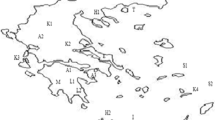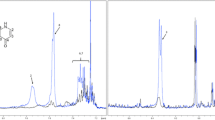Abstract
A non-targeted metabolomic methodology using gas chromatography coupled to mass spectrometry in combination with headspace solid-phase microextraction was applied for the identification of pharmaceutical honey volatile metabolites. Common and rare honeys (citrus, fir, honeydew, pine, thyme, asfaka, arbutus, chestnut, and cotton), in a total of 32 samples, were collected from different regions in Greece. Seventy-three volatile organic compounds (VOCs) were identified and semi-quantified using the internal standard method. Among volatiles, the norisoprenoid 3,4,6,6-tetramethylbicyclo[3.2.1]oct-3-ene-2,8-dione, was identified for the first time to contribute to Greek honey aroma. Pharmaceutical VOCs of interest included: terpenes, norisoprenoids benzene derivatives/phenolic volatiles and other compounds. The content of such metabolites was affected by honey’s botanical origin (p < 0.05). The honey code was developed to construe differences among honey varieties with respect to semi-quantitative data of pharmaceutical volatile metabolites. The exploitation of natural organic compounds for the treatment of diseases is of great value.
Graphical abstract







Similar content being viewed by others
References
Castro-Vázquez L, Díaz-Maroto MC, González-Viñas MA, Perez-Coello MS (2007) Aroma composition and new chemical markers of Spanish citrus honeys. Food Chem 103:601–606
Kadar M, Juan-Borrás M, Carot MJ, Domenech E, Escriche I (2011) Volatile fraction composition and physicochemical parameters as tools for the differentiation of lemon blossom honey and orange blossom honey. J Sci Food Agric 91:2768–2776
Nayik GA, Nanda V (2015) Characterization of the volatile profile of unifloral honey from Kashmir valley of India by using solid-phase microextraction and gas chromatography-mass spectrometry. Eur Food Res Technol 240:1091–1100
Nayik GA, Nanda V (2015) Physico-chemical, enzymatic, mineral and colour characterization of three different varieties of honeys from Kashmir Valley of India with a multivariate approach. Polish J Food Nutr Sci 65(2):101–108
Nayik GA, Nanda V (2016) A chemometric approach to evaluate the phenolic compounds, antioxidant activity and mineral content of different unifloral honey types from Kashmir, India. LWT - Food Sci Technol 74:504–513
Montenegro G, Gómez M, Casaubon G, Belancic A, Mujica AM, Peña RC (2009) Analysis of volatile compounds in three unifloral native Chilean honeys. Int J Exp Bot 78:61–65
Piasenzotto L, Gracco L, Conte L (2003) SPME applied to honey quality control. J Sci Food Agric 83:1037–1044
Manyi-Loh CE, Ndip RN, Clarke AM (2011) Volatile compounds in honey: a review on their involvement in aroma, botanical origin determination and potential biomedical activities. Int J Mol Sci 12:9514–9532
Karabagias IK, Badeka AV, Kontakos S, Karabournioti S, Kontominas MG (2014) Botanical discrimination of Greek unifloral honeys with physico-chemical and chemometric analyses. Food Chem 165:181–190
Alissandrakis E, Kibaris AC, Tarantilis PA, Harizanis PC, Polissiou M (2005) Flavour compounds of Greek cotton honey. J Sci Food Agric 85:1444–1452
Meliou E, Chinou I (2011) Chemical constituents of selected unifloral Greek bee-honeys with antimicrobial activity. Food Chem 129:284–290
Wang G, Tang W, Bidigare RR (2005) In: Zhang L, Demain AL (eds) Terpenoids as therapeutic drugs and pharmaceutical agents. Natural products: drug discovery and therapeutic medicine. Humana Press Inc., Totowa, pp 197–227
Manosroi A, Jantrawut P, Ogihara E, Yamamoto A, Fukatsu M, Yasukawa K, Tokuda H, Suzuki N, Manosroi J, Akihisa T (2013) Biological activities of phenolic compounds and triterpenoids from the galls of Terminalia chebula. Chem Biodivers 10(8):1448–1463
Chew YL, Goh JK, Lim YY (2009) Assessment of in vitro antioxidant capacity and polyphenolic composition of selected medicinal herbs from Leguminosae family in Peninsular Malaysia. Food Chem 119:373–378
Bianchi F, Careri M, Musci M (2005) Volatile norisoprenoids as markers of botanical origin of Sardinian strawberry-tree (Arbutus unedo L.) honey: Characterisation of aroma compounds by dynamic headspace extraction and gas chromatography–mass spectrometry. Food Chem 89:527–532
Eilbracht P, Jelitte R, Trabold P (1986) Regioselective synthesis of substituted bicyclo[3.2.l]oct-3-ene-2,8-diones via double carbonylation of 1,3-cyclohexadienes. Chem Ber 119:169–181
Calogirou A, Larsen BR, Kotzias D (1999) Gas-phase terpene oxidation products: a review. Atmos Environ 33:1423–1439
Bayraktar D, Onoğur TA (2011) Investigation of the aroma impact volatiles in Turkish pine honey samples produced in Marmaris, Datça and Fethiye regions by SPME/GC/MS technique. Int J Food Sci Technol 46:1060–1065
Escriche I, Visquert M, Juan-Borras M, Fito P (2009) Influence of simulated industrial thermal treatments on the volatile fractions of different varieties of honey. Food Chem 112(2):329–338
Petretto GL, Tuberoso CIG, Vlahopoulou G, Atzei A, Mannu A, Zrira S, Pintore G (2016) Volatiles, color characteristics and other physico-chemical parameters of commercial Moroccan honeys. Nat Prod Res 30:286–292
Schwarz G, Gideon E (1978) Estimating the dimension of a model. Ann Stat 6(2):461–464
Celebi ME, Kingravi HA, Vela PA (2013) A comparative study of efficient initialization methods for the k-means clustering algorithm. Expert Syst Appl 40(1):200–210
Miller JN, Miller JC (2010) Statistics and chemometrics for analytical chemistry, 6th edn. Pearson Education Limited, Essex
Acknowledgements
The authors would like to thank local beekeepers and Rhodes and Thassos Beekeeping Associations for the donation of honey samples. Prof. M.G. Kontominas, who provided access to the Laboratory of Food Chemistry at Chemistry Department of University of Ioannina, is greatly acknowledged.
Funding
The present study was not funded.
Author information
Authors and Affiliations
Corresponding author
Ethics declarations
Human and animal rights statement
This article does not contain any studies with human or animal subjects.
Conflict of interest
The authors need funding to expand present research philosophy at an international level.
Electronic supplementary material
Below is the link to the electronic supplementary material.
Rights and permissions
About this article
Cite this article
Karabagias, I.K., Nikolaou, C. & Karabagias, V.K. Volatile fingerprints of common and rare honeys produced in Greece: in search of PHVMs with implementation of the honey code. Eur Food Res Technol 245, 23–39 (2019). https://doi.org/10.1007/s00217-018-3137-x
Received:
Revised:
Accepted:
Published:
Issue Date:
DOI: https://doi.org/10.1007/s00217-018-3137-x




